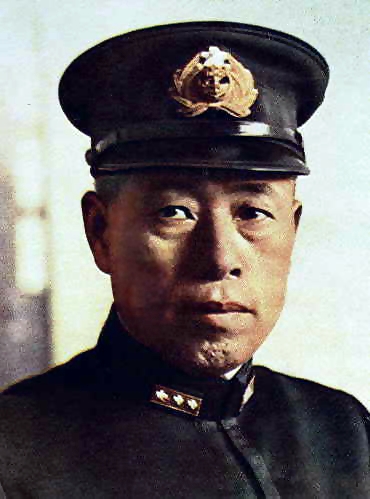Isoroku Yamamoto
Isoroku Yamamoto was a Japanese naval admiral who helped plan the attack on Pearl Harbour and played a major role in the Pacific War until his death in April 1943.
Born in 1884, Yamamoto graduated from the Japanese Naval Academy in 1904. After his graduation he quickly saw active combat in the Russo-Japanese War. In May 1905 Yamamoto fought at the battle of Tsushima Straits in, where he lost two fingers.
Yamamoto was promoted to the rank of Lieutenant Commander in 1916. Yamamoto then spent time in America: from 1919 to 1921, he studied at Harvard University, and subsequently he served as Naval Attaché to the United States.

During the 1930s Yamamoto became known for his expertise in naval aviation. He promoted aircraft carriers, which he thought should become the dominant force in Japan's navy. Aircraft carrier planes (such as the British Swordfish) were usually inferior to land based fighters (such as the British Spitfire): Yamato wanted modern fighter planes to operate from aircraft carriers. In his mission to modernise the Japanese navy he encountered opposition from senior naval officers who trenchantly believed in the supremacy of the battleship. Yamamoto compared the battleship to the samurai sword: both were ferocious weapons in the past, but they were now vestiges of outdated modes of warfare.
During his time in America, Yamamoto was disdainful of the American Navy, which he compared to a leisure club for golfers and bridge players. But for all his contempt, he was keenly aware of US Navy’s strength, especially in the Pacific. He was one of the few senior military figures in Japan to have serious misgivings about challenging America in the Pacific. Yamamoto also opposed the invasion of Manchuria in 1931, the war with China in 1937, and the Japanese pact with Germany and Italy in 1940. These controversial stances made him a target for militaristic Japanese nationalists. In 1939 the navy minister Mitsumasa Yonai sent Yamamoto back to sea as Commander of the Combined Fleet to save him from assassination. He was promoted to the rank of Admiral on 15 November 1940.
In October 1941, Yamamoto’s rival, Hideki Tojo, became Prime Minister of Japan. This did not, however, spell the end of Yamamoto’s naval career. It would have been difficult to side-line Yamamoto: he was greatly respected by his fleet and the naval hierarchy and he had links with the imperial royal family.
Yamamoto retained his deep-set reservations about Japanese involvement in the war, but followed orders to prepare for an attack on America, the greatest threat to Japanese expansion in the Pacific. Yamamoto planned a quick knock-out blow at Pearl Harbour, America’s naval base in Hawaii.
On 7 December 1941, Pearl Harbour was attacked. But a decisive hit was impossible: almost all of America's aircraft carriers based in Pearl Harbour were out at sea at the time of the attack. Yamamoto understood how important these surviving ships were; he also made the prescient prediction that that Japan would be militarily successful for six to 12 months. At the Battle of Midway in June 1942, Japan lost much of her carrier force. Her navy could never recover from this disastrous loss.
In April 1943, Yamamoto decided to conduct an inspection tour of Japanese bases in the South Pacific to boost morale after the defeat at Guadalcanal. American intelligence managed to decode a Japanese message and learnt that Yamamoto planned on visiting the northern Solomon Islands on 18 April. The decoded message specified locations and gifted the Americans arrival and departure times and transportation details. The Americans decided to take out Yamamoto in an operation entitled ‘Operation Vengeance’.
'Operation Vengeance' was carried out by 16 P-38 Lightning fighters from the 339th Fighter Squadron. They were required to intercept and shoot down Yamamoto's plane. The operation was successful and Yamamoto was killed. Yamamoto's death severely damaged morale in the Japanese military.
After his death, Yamamoto was showered with posthumous honours by Axis powers. He was promoted to the highest rank of Fleet Admiral, awarded the Order of the Chrysanthemum, First Class, and awarded the Knight's Cross with oak leaves by Nazi Germany, making him the first foreigner to receive the decoration.
MLA Citation/Reference
"Isoroku Yamamoto". HistoryLearning.com. 2025. Web.
